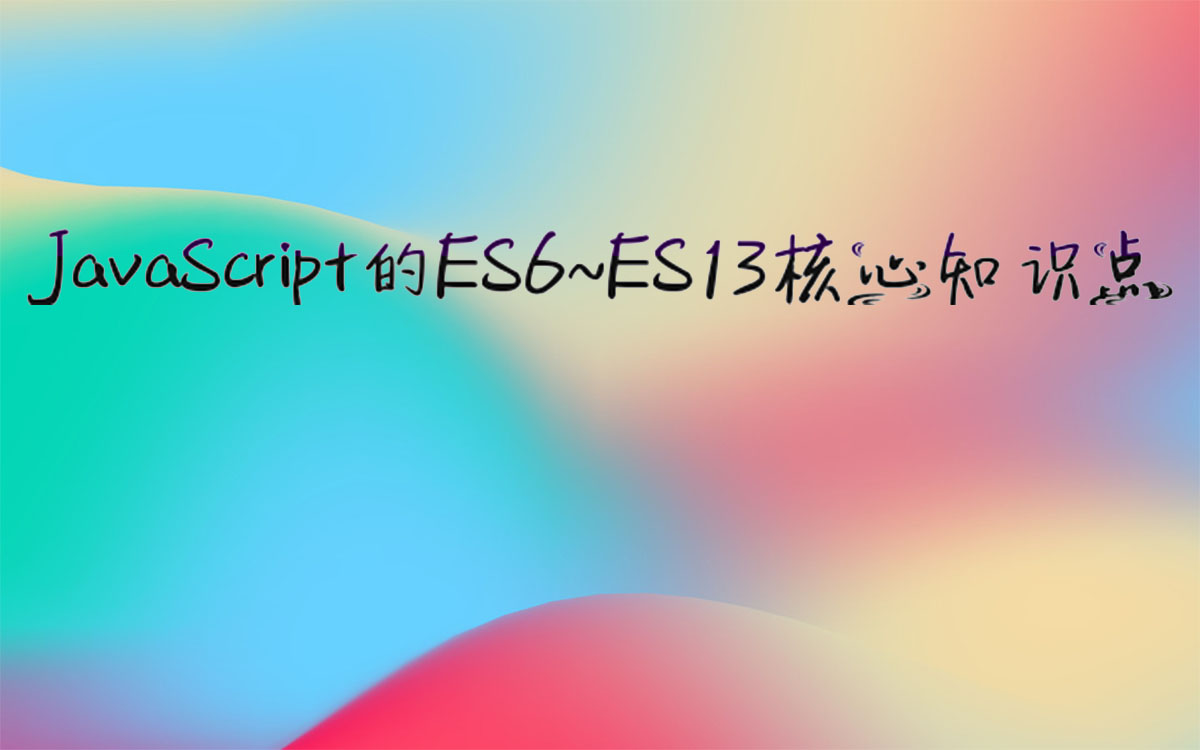JavaScript的ES7~ES13知识点

JavaScript的ES7~ES13知识点
coderwhy一. ES7 知识点
1.1. Array Includes
在 ES7 之前,如果我们想判断一个数组中是否包含某个元素,需要通过 indexOf 获取结果,并且判断是否为 -1。
在 ES7 中,我们可以通过 includes 来判断一个数组中是否包含一个指定的元素,根据情况,如果包含则返回 true,否则返回 false。
语法如下:
arr.includes(valueToFind[, fromIndex])
1 | const names = ["abc", "cba", "nba", "why"]; |
并且对于 NaN、undefined 的查找,includes 要好于 indexOf:
1 | const names = ["abc", "cba", "nba", "why", NaN]; |
1.2. 平方运算符
在 ES7 之前,计算数字的平方需要通过 Math.pow 方法来完成。
在 ES7 中,增加了 ** 运算符,可以对数字来计算平方。
1 | const result1 = Math.pow(3, 3); |
二. ES8 知识点
2.1. Object values
之前我们可以通过 Object.keys 获取一个对象所有的 key,在 ES8 中提供了 Object.values 来获取所有的 value 值:
1 | const obj = { |
2.2. Object entries
通过Object.entries 可以获取到一个数组,数组中会存放可枚举属性的键值对数组。
1 | const obj = { |
2.3. Object Descriptors
ES8 中增加了另一个对对象的操作是 Object.getOwnPropertyDescriptors ,这个在之前已经讲过了,这里不再重复。
2.4. String Padding
某些字符串我们需要对其进行前后的填充,来实现某种格式化效果,ES8 中增加了 padStart 和 padEnd 方法,分别是对字符串的首尾进行填充的。
1 | const message = "Hello World"; |
我们简单具一个应用场景:比如需要对身份证、银行卡的前面位数进行隐藏:
1 | const cardNumber = "3242523524256245223879"; |
2.5. Trailing Commas
在 ES8 中,我们允许在函数定义和调用时多加一个逗号:
1 | function foo(a, b) { |
三. ES9 知识点
ES9 中新增的知识点主要有三个:
3.1. Async iterators
后续迭代器讲解
3.2. Object spread operators;
前面讲过了
3.3. Promise finally;
后续讲 Promise 讲解
四. ES10 知识点
4.1. flat flatMap
flat() 方法会按照一个可指定的深度递归遍历数组,并将所有元素与遍历到的子数组中的元素合并为一个新数组返回。
1 | const nums = [ |
flatMap() 方法首先使用映射函数映射每个元素,然后将结果压缩成一个新数组。
注意一:flatMap 是先进行 map 操作,再做 flat 的操作;
注意二:flatMap 中的 flat 相当于深度为 1;
1 | const messages = ["Hello World", "你好啊 李银河", "my name is why"]; |
4.2. Object formEntries
在前面,我们可以通过 Object.entries 将一个对象转换成 entries,那么如果我们有一个 entries 了,如何将其转换成对象呢?
- ES10 提供了 Object.formEntries 来完成转换:
1 | const obj = { |
那么这个方法有什么应用场景呢?
1 | const paramsString = "name=why&age=18&height=1.88"; |
4.3. trimStart trimEnd
去除一个字符串首尾的空格,我们可以通过 trim 方法,如果单独去除前面或者后面呢?
- ES10 中给我们提供了 trimStart 和 trimEnd;
1 | const message = " Hello World "; |
4.4. Symbol description
已经讲过了(讲解 Symbol 的时候)
4.5. Optional catch binding
后面讲解 try cach 讲解
五. ES11 知识点
5.1. BigInt
在早期的 JavaScript 中,我们不能正确的表示过大的数字:
- 大于 MAX_SAFE_INTEGER 的数值,表示的可能是不正确的。
1 | const maxInt = Number.MAX_SAFE_INTEGER; |
那么 ES11 中,引入了新的数据类型 BigInt,用于表示大的整数:
- BitInt 的表示方法是在数值的后面加上 n
1 | const bigInt = 9007199254740991n; |
BigInt 可以将其他数据类型转成 BigInt:
1 | const bigInt1 = BigInt(10); |
5.2. Dynamic Import
后续 ES Module 模块化中讲解。
5.3. Nullish Coalescing Operator
ES11,Nullish Coalescing Operator 增加了空值合并操作符:
1 | const foo = ""; |
5.4. Optional Chaining
可选链也是 ES11 中新增一个特性,主要作用是让我们的代码在进行 null 和 undefined 判断时更加清晰和简洁:
1 | const obj = { |
可选链可以帮助我们在有值的情况下返回对应的值,没有值的情况下返回 undefined:
1 | // 可选链的方式 |
5.5. Promise.allSettled
后续讲 Promise 的时候讲解。
5.6. Global This
在之前我们希望获取 JavaScript 环境的全局对象,不同的环境获取的方式是不一样的
比如在浏览器中可以通过 this、window 来获取;
比如在 Node 中我们需要通过 global 来获取;
那么在 ES11 中对获取全局对象进行了统一的规范:globalThis
1 | console.log(globalThis); |
5.7. import meta
后续 ES Module 模块化中讲解。
5.8. for..in 标准化
在 ES11 之前,虽然很多浏览器支持 for…in 来遍历对象类型,但是并没有被 ECMA 标准化。
在 ES11 中,对其进行了标准化,for…in 是用于遍历对象的 key 的:
1 | const obj = { |
六. ES12 知识点
6.1. FinalizationRegistry
FinalizationRegistry 对象可以让你在对象被垃圾回收时请求一个回调。
FinalizationRegistry提供了这样的一种方法:当一个在注册表中注册的对象被回收时,请求在某个时间点上调用一个清理回调。(清理回调有时被称为 finalizer );你可以通过调用
register方法,注册任何你想要清理回调的对象,传入该对象和所含的值;
1 | let obj = { |
6.2. WeakRefs
如果我们默认将一个对象赋值给另外一个引用,那么这个引用是一个强引用:
- 如果我们希望是一个弱引用的话,可以使用 WeakRef;
1 | let obj = { |
6.3. logical assignment operators
1 | // 1.逻辑或运算符 |
6.4. Numeric Separator
1 | // ES2021新增特性 |
七. ES13 知识点
更新 ing ~~~
文章转载于coderwhy | JavaScript 高级系列(十五) - ES6ES13-ES7ES12 知识点















